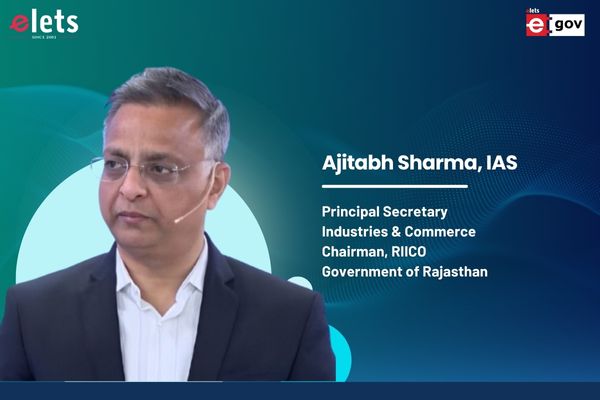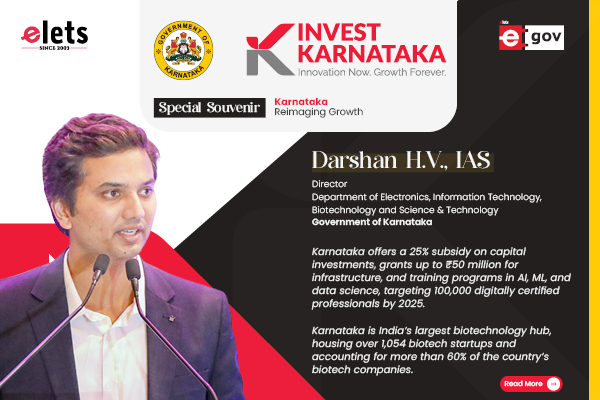
From heritage preservation to adoption of clean transportation; from affordable housing to integrated waste management, Dr Adarsh Singh (IAS), Divisional Commissioner, Jhansi Division, Government of Uttar Pradesh shares his administrative experience of transforming Jhansi into smart and sustainable city in an exclusive interview with Nisha Samant of Elets News Network (ENN). Edited excerpts:
Urban planning plays a crucial role in shaping the development of cities. Could you elaborate on the key urban planning initiatives you’ve spearheaded in District Jhansi to ensure sustainable and organised urban growth while preserving the city’s historical significance?

In District Jhansi, we’ve spearheaded urban planning initiatives that harmonise growth with heritage preservation. Notably, the “Landscaping near Jhansi Fort Vicinity” and “Restoration of Old Gates” along with “Heritage Street Project” revitalises historic sites of Jhansi, blending modern amenities with historical architecture. Our Jhansi Master Plan 2031 promotes mixed-use zoning, reducing urban sprawl and fostering sustainability. Our “Electric Buses” project provides a smart transportation system which optimises traffic flow, minimising congestion and pollution. “Redevelopment of Narayan Bagh” project integrates green spaces through parks and tree-lined avenues, enhancing aesthetics and air quality. “Restoration of Pani Wali Dharmshala” and “Development of Laxmi Taal” projects have rejuvenated water bodies in the city. “Iconic Roads” project reclaims public areas by creating safe and beautified public spaces ,creating footpaths and cycling tracks to promote walking and cycling. These efforts synergize heritage preservation, sustainable development, and improved quality of life, positioning District Jhansi as a model for balanced urban growth.

As the Divisional Commissioner, you’ve been involved in the transformation of Jhansi into a smart city. Could you share some of the innovative technologies and strategies you’ve implemented to enhance urban services, improve citizen engagement, and promote efficient resource management within the city?

As Divisional Commissioner leading Jhansi’s smart city transformation, I’ve introduced innovative technologies like an integrated city management system, enabling real-time monitoring of services like waste management and traffic control. Citizen engagement is heightened through a dedicated mobile app, allowing residents to report issues and receive updates. Smart street lighting control and management system and reusing of treated STP water in gardens and lakes promote resource conservation.

Additionally, we’ve implemented a data-driven approach, using AI for traffic optimization and predictive maintenance. Through public-private partnerships, we’ve established Wi-Fi hotspots and digital kiosks for accessible information dissemination. These strategies foster seamless urban services, empower citizens, and ensure sustainable resource allocation, elevating Jhansi’s status as a smart city.
Clean transport is an essential component of reducing pollution and congestion in urban areas. Can you highlight the steps taken in Jhansi to promote clean and sustainable transportation options, such as electric vehicles and improved public transportation systems?
Absolutely, in Jhansi, we’ve taken significant steps to promote clean and sustainable transportation. Firstly, to promote public transportation, we have invested in a large fleet of city electric buses along with a mobile app which shows their real time location and estimated time of arrival. We are establishing an extensive network of electric vehicle (EV) charging stations throughout the city to encourage the adoption of electric vehicles.
To promote cycling, we are implementing a 200 Public Bicycle Sharing Project with hubs at important locations such as University, bus stops, railway stations and crowded markets. Dedicated cycle tracks are being introduced to encourage eco-friendly modes of transportation.
We have a fleet of electric tourist vehicles and electric Hop on Hop Off buses in PPP mode to promote sustainable tourism.
Furthermore, our urban planning focuses on creating pedestrian-friendly zones and improving last-mile connectivity through shared mobility services. These combined efforts promote clean transport options, reduce pollution, and alleviate congestion, making Jhansi a greener and more livable city.
Affordable housing is a critical challenge in rapidly growing cities. What innovative approaches have you adopted to ensure that urban residents in Jhansi have access to decent and affordable housing while maintaining the balance between urban expansion and green spaces?
To address affordable housing challenges in Jhansi, we’ve embraced innovative approaches. Firstly, we’ve implemented mixed-use zoning, optimising land use for both housing and commercial spaces. This reduces the strain on available land while promoting a balanced urban environment. Through public-private partnerships, we’ve launched affordable housing projects with low-cost construction technologies, ensuring quality living spaces at reduced costs. These projects incorporate energy-efficient designs, aligning with sustainability goals.
To maintain green spaces, we’ve adopted a policy of vertical expansion, encouraging taller buildings while preserving ground- level green areas. Rooftop gardens and community parks are integrated within housing complexes, enhancing the urban landscape. Certain green spaces have been earmarked in the Master Plan on which no construction activity is allowed, preserving these green spaces.
Furthermore, incentives are offered to developers who include affordable housing units in their projects, ensuring inclusivity in prime areas. We are taking up in situ slum redevelopment projects in PPP mode as well.
By combining these strategies, we’ve managed to provide access to affordable housing while fostering green spaces and sustainable urban expansion in Jhansi.
Creating sustainable townships involves balancing economic growth with environmental stewardship. Could you share examples of how you’ve fostered the development of sustainable townships within District Jhansi, integrating green infrastructure, waste management systems, and renewable energy solutions?
Certainly, in District Jhansi, we’ve championed sustainable township development through a holistic approach. For all townships above a particular area, recycling and reuse of waste water in gardening, composting, usage of solar power, setting up of STP is mandatory. These elements enhance biodiversity, manage stormwater, and improve air quality.
Waste management is a priority, with the Integrated Waste Management Project focusing on ‘Door to Door’ collection through 200 vehicles and setting up of 10 decentralised waste processing units. This reduces landfill dependency and promotes recycling and composting.
Renewable energy is integrated through the “Rooftop Solar Power” project, requiring solar panels on rooftops and common areas creating 170 KW capacity. This has resulted in stopping generation of 2 lakh KG CO2 in the past one year and financial savings of more than Rs 50 lakhs.
Rainwater harvesting is being promoted in all buildings, with 88,000 thousand square metre area covered under this through Smart City Project leading to conservation of 5.71 crore litres of water in the past 2 years.
Moreover, the “Sustainable Mobility Plan” emphasises pedestrian-friendly pathways, Public bicycle Sharing, dedicated cycling lanes, and efficient public transportation between townships minimises vehicular emissions.
Through these initiatives, we’ve successfully created sustainable townships that balance economic growth with environmental stewardship, ensuring a thriving and green urban landscape in District Jhansi.
Be a part of Elets Collaborative Initiatives. Join Us for Upcoming Events and explore business opportunities. Like us on Facebook , connect with us on LinkedIn and follow us on Twitter, Instagram.
"Exciting news! Elets technomedia is now on WhatsApp Channels Subscribe today by clicking the link and stay updated with the latest insights!" Click here!













